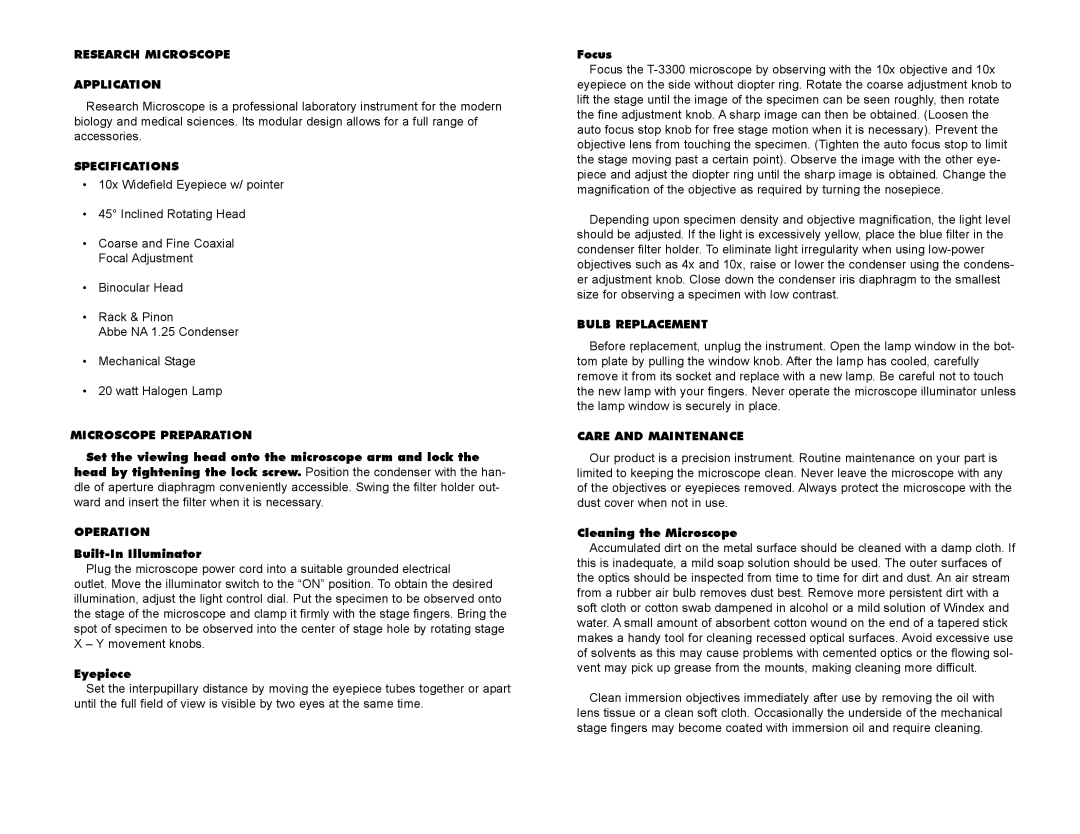RESEARCH MICROSCOPE
APPLICATION
Research Microscope is a professional laboratory instrument for the modern biology and medical sciences. Its modular design allows for a full range of accessories.
SPECIFICATIONS
•10x Widefield Eyepiece w/ pointer
•45° Inclined Rotating Head
•Coarse and Fine Coaxial Focal Adjustment
•Binocular Head
•Rack & Pinon
Abbe NA 1.25 Condenser
•Mechanical Stage
•20 watt Halogen Lamp
MICROSCOPE PREPARATION
Set the viewing head onto the microscope arm and lock the head by tightening the lock screw. Position the condenser with the han- dle of aperture diaphragm conveniently accessible. Swing the filter holder out- ward and insert the filter when it is necessary.
OPERATION
Plug the microscope power cord into a suitable grounded electrical outlet. Move the illuminator switch to the “ON” position. To obtain the desired illumination, adjust the light control dial. Put the specimen to be observed onto the stage of the microscope and clamp it firmly with the stage fingers. Bring the spot of specimen to be observed into the center of stage hole by rotating stage X – Y movement knobs.
Eyepiece
Set the interpupillary distance by moving the eyepiece tubes together or apart until the full field of view is visible by two eyes at the same time.
Focus
Focus the
Depending upon specimen density and objective magnification, the light level should be adjusted. If the light is excessively yellow, place the blue filter in the condenser filter holder. To eliminate light irregularity when using
BULB REPLACEMENT
Before replacement, unplug the instrument. Open the lamp window in the bot- tom plate by pulling the window knob. After the lamp has cooled, carefully remove it from its socket and replace with a new lamp. Be careful not to touch the new lamp with your fingers. Never operate the microscope illuminator unless the lamp window is securely in place.
CARE AND MAINTENANCE
Our product is a precision instrument. Routine maintenance on your part is limited to keeping the microscope clean. Never leave the microscope with any of the objectives or eyepieces removed. Always protect the microscope with the dust cover when not in use.
Cleaning the Microscope
Accumulated dirt on the metal surface should be cleaned with a damp cloth. If this is inadequate, a mild soap solution should be used. The outer surfaces of the optics should be inspected from time to time for dirt and dust. An air stream from a rubber air bulb removes dust best. Remove more persistent dirt with a soft cloth or cotton swab dampened in alcohol or a mild solution of Windex and water. A small amount of absorbent cotton wound on the end of a tapered stick makes a handy tool for cleaning recessed optical surfaces. Avoid excessive use of solvents as this may cause problems with cemented optics or the flowing sol- vent may pick up grease from the mounts, making cleaning more difficult.
Clean immersion objectives immediately after use by removing the oil with lens tissue or a clean soft cloth. Occasionally the underside of the mechanical stage fingers may become coated with immersion oil and require cleaning.
